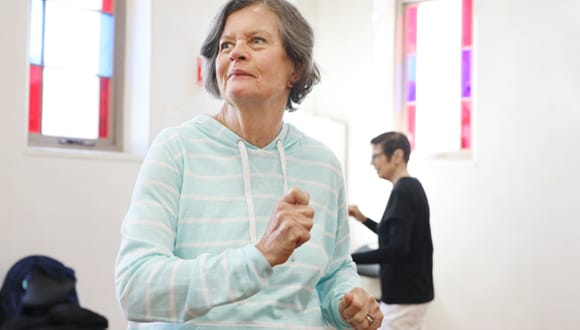Living with Parkinson's disease
Though a cure is still a far-off goal for Parkinson’s researchers, recent studies have reported promising results in the areas of diagnosis and treatment.
Health Agenda magazine
October 2018
About 14 years ago, Christine Clark sat in her parked car outside the neurologist’s office with tears streaming down her face. “I just remember sitting there, stunned, not knowing what to do, and crying.” She had fled the doctor’s office minutes earlier after he told her she had Parkinson’s disease.
“I didn’t know anything about Parkinson’s, because I’d never known anybody with it,” Clark recalls. Her mind raced through the endless questions: how will I tell my kids? What’s the outcome? How does it progress? She had almost no knowledge of the condition, except that it was going to completely alter her plans for the future. “I kept thinking, ‘Old people get Parkinson’s. 55-year-olds don’t get Parkinson’s.’”

Parkinson’s in Australia
Parkinson’s disease is a degenerative neurological disorder with no known cause. It damages the brain cells responsible for producing the neurotransmitter dopamine. One of dopamine’s functions is to regulate communication in the part of the brain that controls motor function. So having less dopamine impacts movement and can produce the wide range of symptoms, including tremors, muscle rigidity, slow movement, a stooped posture and memory difficulties.
Some early symptoms you may not associate with Parkinson’s. These include fatigue, mild depression, muscle pain and even changes in your handwriting.
The median age for diagnosis in Australia is 65, but 5 – 10% of people who are diagnosed with Parkinson’s will have developed it earlier. Parkinson’s Australia reports it affects approximately 81,000 Australians, and with an ageing population, that number is expected to grow.
Reimagining the future
Two weeks after she was told she had Parkinson’s, Clark and her partner John returned to the neurologist’s office and began their journey with the disease. “In Parkinson’s… there’s just so much loss,” Clark says. “You lose the ability for your body to do what it wants to do. I had to give up work before I was ready.”
But with the support of her partner and family, Clark began reshaping her vision for the future. Experts, patients and carers agree that this is one of the biggest challenges of dealing with the diagnosis.
The importance of community
Support is critical for people living with Parkinson’s, according to Steve Sant, CEO of Parkinson’s Australia. One of the reasons is the high incidence of depression and anxiety among people with Parkinson’s.
As well as controlling motor function, dopamine is linked to our emotional responses and mood.
“It’s a sort of ‘feel-good’ neurotransmitter, and if you have less of it, it’s going to have a big impact,” says Sant.
One of the ways Clark has remained positive is through exercise. As well as her weekly group physio sessions, she attends dance classes at Dance for Parkinson’s Australia, which runs classes for Parkinson’s patients and their families.
“We have a focus on community in our classes,” says program director Erica Rose Jeffrey, “so caregivers, partners and family members are all welcome in the class.”
The program began in 2001, when someone from the Parkinson’s community approached the Mark Morris Dance Group in New York and requested a dance class for people with the disease. There are now more than 100 Dance for Parkinson’s classes around the world.
“You get to move your body in a different way, and sometimes even forget that you’ve got Parkinson’s, because you get involved in the music and it’s such a lovely experience,” says Clark.
There’s growing evidence of the benefits of exercise for people with Parkinson’s. A small study from Charlotte in the US suggests exercise is linked to neuroplasticity in people with Parkinson’s, helping the brain to change its connections.
Research published in Frontiers in Aging Neuroscience says that not only can exercise potentially reduce the risk of developing Parkinson’s but it may also benefit people with Parkinson’s by protecting dopamine neurons.
Professor Simon Lewis of the University of Sydney’s Brain and Mind Centre is more cautious. “We have some good – but not overwhelmingly convincing – data that exercise can improve symptoms. Whether that really equates to a slow-down in cell death, which is what we’re talking about, I don’t know. But the bottom line is, there is no doubt that it is good for all of us.”
Sant agrees. “I’ve been to Dance for Parkinson’s classes, and the thing that I saw, more than the documented evidence, was that everyone came out with a smile on their face. If that’s the worst thing that happens to you, then that’s a good thing.”
Image credit: Chris Elfes
Related articles
WHY FUN IS SERIOUSLY GOOD FOR YOU
Fun isn't just fun – it can actually be good for your health.
7 REASONS YOU SHOULD EXERCISE (THAT HAVE NOTHING TO DO WITH FITNESS)
Exercise doesn’t just keep you trim, it enhances your wellbeing from head to toe. Here’s how.
SERIOUS CONDITIONS THAT CAN BE MISSED
Many serious conditions have vague or hidden symptoms. Here’s how to identify and screen for them.
LIVING WITH A CHRONIC DISEASE
Being diagnosed with a chronic illness can be an emotional and challenging time, but your mindset can have an impact on how you cope.